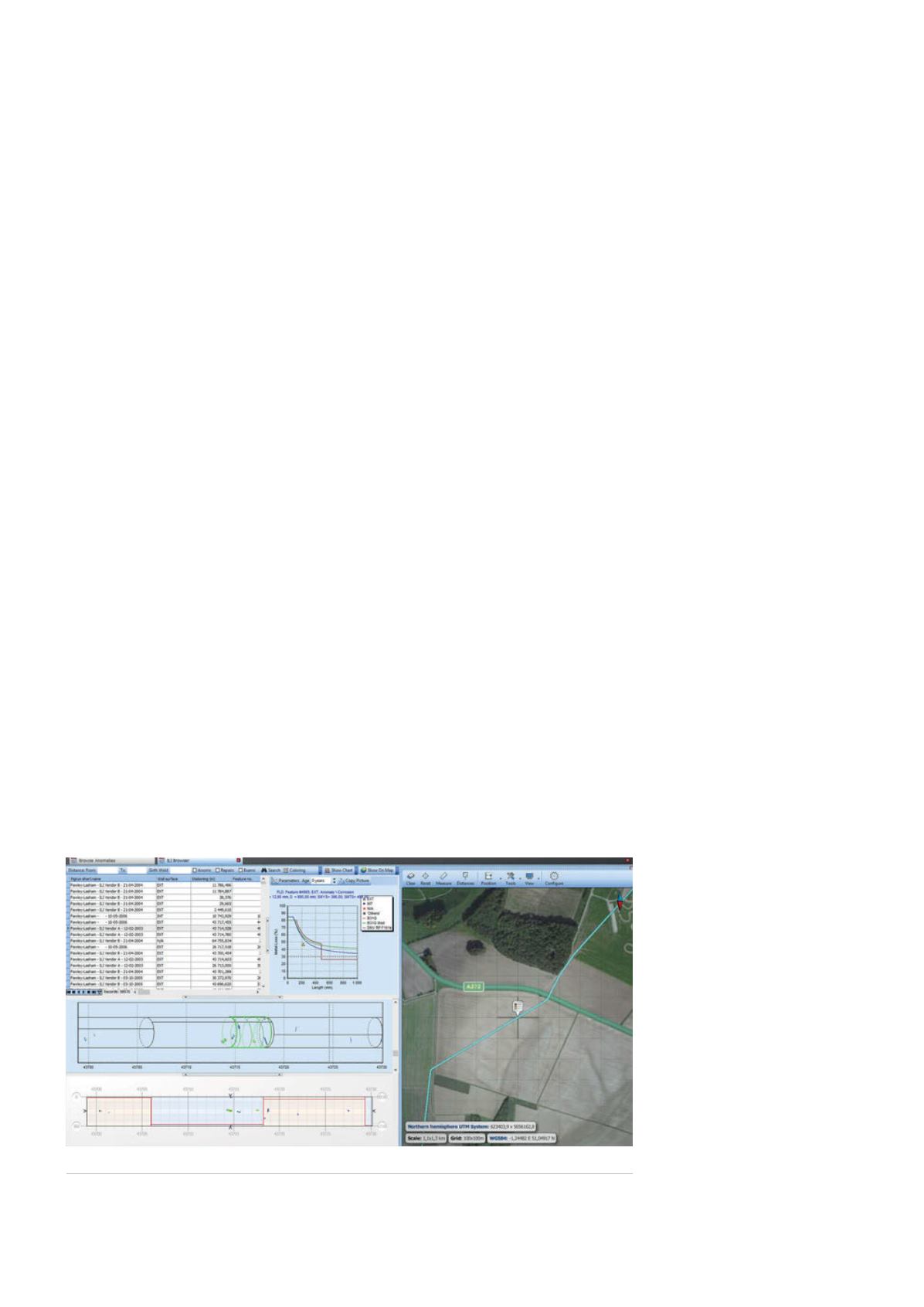
inspection (ILI) Expert module – to interpret and manage vast
amounts of data in order to manage the everyday activities
related to pipeline integrity.
For key decisions to be made effectively, the gathering
and interpreting of large amounts of correct data becomes
an important task. The best way to resolve this problem is to
transfer client data to a single uniform relational database.
Storing and analysing pipeline data in a single source can
be achieved by connecting different sources of data into a
consistent and clearly defined format.
With this information available, the operator can analyse
the relationship between the different data, and make
appropriate decisions when proposing pipeline inspections,
repair plans and further preventative measures.
Inspection management
Today, ILI vendors provide inspections in a report that contains
a list of all ‘features’, which have been encountered in the
course of the ILI tool ‘run’.
One of the main features of the PiMSlider ILI Expert
module is the ability to upload these reports (commonly
known as a pipe tally report) into the PiMSlider database.
As ILI vendors can provide the data in different file formats,
the ILI Expert module is equipped with a flexible mechanism
for describing different templates allowing engineers or
integrity specialists to upload almost any spread sheet of any
structure – whether the report is in CSV, MS Excel or even
MS Access format. To ensure the data can be used correctly
in the software (and features utilised to their full potential),
it is advisable to keep to a certain classification of features,
such as ‘anomaly’, ‘corrosion’, and ‘dent’. For example, one of
the ILI Expert CSV upload formats/templates conforms to the
Pipeline Operator Forum 3.2 data format; a standard commonly
used for ILI. Although not mandatory, it is desirable that all
inspections in a particular system use the same specification.
Using templates allows an expert to easily upload any ILI
report from any vendor into the PiMSlider database without
the help of the software designer or IT specialist.
The database stores pipeline stationing (construction) data
(depending when and how the client has organised this linear
data). During the ILI data upload process, the log distance of
features (logged during the ILI process) is uploaded into the
database.
The challenge is then to align the uploaded log
distances from the new ILI report, with the existing pipeline
stationing data. The ILI Expert provides the appropriate tools
(automated, manual or a combination of both) to align these
points – resulting in the ILI features being connected to the
correct, or very close, points along the pipeline. Additionally,
the software can automatically calculate the co-ordinates of
all defects even if they were not provided in the report.
The result of this data linking process is that the
anomalies/cracks/dents found as part of the ILI can now be
physically located at the correct point along the pipeline.
Feature analysis
Another major feature of the ILI Expert module is to be able
to analyse inspections in some considerable detail. With
each reported defect, the user can determine whether the
defect is dangerous on its own, how close the defect is to
other defects, how the proximity of the defect can affect the
integrity of the pipe at that location, and how far girth and
longitudinal welds are from the defect. All of these (and many
other) issues will be extremely important for the integrity
engineer.
By using the ‘browse anomalies’ function of the ILI Expert
module, integrity engineers can conveniently visualise and
analyse every aspect related to the defects, their danger,
as well as calculating safe and burst pressures and different
methods of repairs.
Along with visualising defects, it is possible to show any
repairs that are either already completed or planned, as well
as casings and other parts of the pipeline system found by the
ILI tool and which may be of interest during defect analysis.
The ILI Expert module also allows the user to calculate a
variety of strength characteristics for pipelines with defects.
Additionally, the user can
create calculation algorithms
and embed them into the
software. The ILI Expert module
is delivered with pre-configured
algorithms for corrosion defects
based on industry standards,
such as B31G, B31G Modified,
DNV Recommended Practice
(RP) F101b.
Once the integrity engineer
has finished analysing ILI
defects, there may be a need to
perform certain actions, such
as repairs or further research.
The engineer can automatically
create a set of documents in
order to carry out, for example,
excavations.
Figure 1.
PiMSlider – ILI Expert module.
38
World Pipelines
/
FEBRUARY 2016


